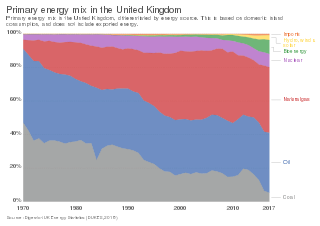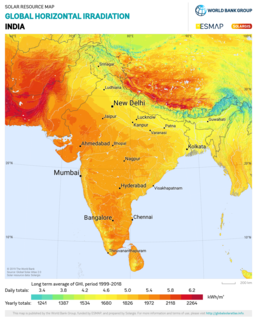The National Hydrogen Energy Road Map (NHERM) is a program in India initiated by the National Hydrogen Energy Board (NHEB) in 2003 and approved in 2006 for bridging the technological gaps in different areas of hydrogen energy, including its production, storage, transportation and delivery, applications, safety, codes and standards and capacity building for the period up to 2020. [1] [2] [3] The program is under direction of the Ministry of New and Renewable Energy (MNRE). [4]
The project aims to reduce India's dependence on import of petroleum products, promote the use of diverse, domestic, and sustainable new and renewable energy sources; to provide electricity to remote, far‐flung, rural and other electricity deficient areas and promote use of hydrogen as a fuel for transport and power generation; to reduce carbon emissions from energy production and consumption, to increase reliability and efficiency of electricity generation; to generate 1000 MW electricity using fuel cells by 2020 and 1 Million vehicles running on Hydrogen based IC Engines and fuel cells by 2020.

A hydrogen vehicle is a vehicle that uses hydrogen fuel for motive power. Hydrogen vehicles include hydrogen-fueled space rockets, as well as automobiles and other transportation vehicles. The power plants of such vehicles convert the chemical energy of hydrogen to mechanical energy either by burning hydrogen in an internal combustion engine, or, more commonly, by reacting hydrogen with oxygen in a fuel cell to run electric motors. Widespread use of hydrogen for fueling transportation is a key element of a proposed hydrogen economy.
The hydrogen economy is the use of hydrogen as a low carbon fuel, particularly for heat; but also for hydrogen vehicles, seasonal energy storage and long distance transport of energy. In order to phase out fossil fuels and limit global warming, hydrogen is starting to be used as it can be created from water, and its combustion only releases water and no CO
2 to the atmosphere. Hydrogen is a powerful fuel - indeed a frequent component in rocket fuel - but there exist numerous technical challenges preventing the creation of a working large-scale hydrogen economy. Among these include the difficulty of developing long-term storage, pipelines and engine equipment due to hydrogen embrittlement, a relative lack of off-the-shelf engine technology that can currently run safely on hydrogen, safety concerns due to the high explosiveness/reactivity of hydrogen fuel with environmental oxygen in the air, and a lack of efficient photochemical water splitting technology to provide sufficient fuel.
Hydrogen fuel is a zero-emission fuel burned with oxygen. It can be used in fuel cells or internal combustion engines. It has begun to be used in commercial fuel cell vehicles, such as passenger cars, and has been used in fuel cell buses for many years. It is also used as a fuel for spacecraft propulsion.

Sustainable energy is energy produced and used in such a way that it "meets the needs of the present without compromising the ability of future generations to meet their own needs."

A fuel cell vehicle (FCV) or fuel cell electric vehicle (FCEV) is an electric vehicle that uses a fuel cell, sometimes in combination with a small battery or supercapacitor, to power its onboard electric motor. Fuel cells in vehicles generate electricity generally using oxygen from the air and compressed hydrogen. Most fuel cell vehicles are classified as zero-emissions vehicles that emit only water and heat. As compared with internal combustion vehicles, hydrogen vehicles centralize pollutants at the site of the hydrogen production, where hydrogen is typically derived from reformed natural gas. Transporting and storing hydrogen may also create pollutants.

The energy policy of the United States is determined by federal, state, and local entities in the United States, which address issues of energy production, distribution, and consumption, such as building codes and gas mileage standards. Energy policy may include legislation, international treaties, subsidies and incentives to investment, guidelines for energy conservation, taxation and other public policy techniques.

Taiwan relies on imports for almost 98% of its energy in 2016, which leaves the island's energy supply vulnerable to external disruption. In order to reduce this dependence, the Ministry of Economic Affairs' Bureau of Energy has been actively promoting energy research at several universities since the 1990s.

The current energy policy of the United Kingdom is set out in the Energy White Paper of May 2007 and Low Carbon Transition Plan of July 2009, building on previous work including the 2003 Energy White Paper and the Energy Review Report in 2006. It was led by the Department of Energy and Climate Change, then headed by Amber Rudd. The current focus of policy are on reforming the electricity market, rolling out smart meters and improving the energy efficiency of the UK building stock through the Green Deal.
The energy policy of India is largely defined by the country's expanding energy deficit and increased focus on developing alternative sources of energy, particularly nuclear, solar and wind energy. India attained 63% overall energy self-sufficiency in 2017.
A low-carbon economy (LCE), low-fossil-fuel economy (LFFE), or decarbonised economy is an economy based on low-carbon power sources that therefore has a minimal output of greenhouse gas (GHG) emissions into the atmosphere, specifically carbon dioxide. GHG emissions due to anthropogenic (human) activity are the dominant cause of observed global warming since the mid-20th century. Continued emission of greenhouse gases may cause long-lasting changes around the world, increasing the likelihood of severe, pervasive, and irreversible effects for people and ecosystems.

The production of renewable energy in Scotland is an issue that has come to the fore in technical, economic, and political terms during the opening years of the 21st century. The natural resource base for renewable energy is extraordinary by European, and even global standards, with the most important potential sources being wind, wave, and tide.

The Ministry of New and Renewable Energy (MNRE) is a ministry of the Government of India that is mainly responsible for research and development, intellectual property protection, and international cooperation, promotion, and coordination in renewable energy sources such as wind power, small hydro, biogas, and solar power.

About 85% of the total primary energy supply in Iceland is derived from domestically produced renewable energy sources. This is the highest share of renewable energy in any national total energy budget. Geothermal energy provided about 65% of primary energy in 2016, the share of hydropower was 20%, and the share of fossil fuels was 15%.

Solar power in India is a fast developing industry. The country's solar installed capacity was 35,122 MW as of 30 June 2020. India has the lowest capital cost per MW globally of installing solar power plants.
A hydrogen infrastructure is the infrastructure of hydrogen pipeline transport, points of hydrogen production and hydrogen stations for distribution as well as the sale of hydrogen fuel, and thus a crucial pre-requisite before a successful commercialization of automotive fuel cell technology.
Japan's hydrogen highway is a network of hydrogen filling stations placed along roadsides that provide fuel for hydrogen fuel cell vehicles (HFCV). An HFCV is a vehicle that uses a fuel cell to convert hydrogen energy into electrical energy. The hydrogen that is used in fuel cell vehicles can be made using fossil or renewable resources. The hydrogen highway is necessary for HFCVs to be used. HFCV reduce tailpipe emissions of greenhouse gases. By May 2016, there were approximately 80 hydrogen fueling stations in Japan.

India is one of the countries with large production of energy from renewable sources. As of 31 March 2020, 35.86% of India's installed electricity generation capacity is from renewable sources, generating 21.22% of total utility electricity in the country.

The principle of a fuel cell was discovered by Christian Friedrich Schönbein in 1838, and the first fuel cell was constructed by Sir William Robert Grove in 1839. The fuel cells made at this time were most similar to today's phosphoric acid fuel cells. Most hydrogen fuel cells today are of the proton exchange membrane (PEM) type. A PEM converts the chemical energy released during the electrochemical reaction of hydrogen and oxygen into electrical energy. The Energy Policy Act of 1992 was the first national legislation that called for large-scale hydrogen research. A five-year program was conducted that investigated the production of hydrogen from renewable energy sources and the feasibility of existing natural gas pipelines to carry hydrogen. It also called for the research into hydrogen storage systems for electric vehicles and the development of fuel cells suitable to power an electric motor vehicle.
The Finland National Renewable Energy Action Plan is the National Renewable Energy Action Plan (NREAP) for Finland. The plan was commissioned by the Directive 2009/28/EC which required Member States of the European Union to notify the European Commission with a road map. The report describes how Finland planned to achieve its legally binding target of a 38% share of energy from renewable sources in gross final consumption of energy by 2020.

The renewable energy transition is the ongoing energy transition replacing fossil fuels with renewable energy. This transition can impact many aspects of life including the environment, society, the economy and governance.